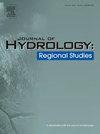Evaluating stream power distribution along river longitudinal profiles using Log S – log A plots
IF 4.7
2区 地球科学
Q1 WATER RESOURCES
引用次数: 0
Abstract
Study region
Eighteen main rivers in Taiwan.
Study focus
This study focused on the analysis of total stream power (TSP) and specific stream power (SSP) along river longitudinal profiles, which are critical indicators of river dynamics. A new two-parameter regression model is proposed, addressing inaccuracies in traditional models and providing a more-precise representation of river profiles. By incorporating concavity, drainage area distribution, discharge, and river width relationships, the model identifies the locations of the TSP and SSP peaks. The study employs log (river slope, S) – log (drainage area, A) plots to evaluate the spatial variability of these metrics under diverse geomorphological and hydrological conditions.
New hydrological insights for the region
The model was used to categorize 18 rivers in Taiwan into three groups based on river source elevation and drainage area–flow length exponents. Key findings indicate that lower source elevations correspond to increased upstream drainage-area distribution and greater concavity. This highlights the interplay between intrinsic watershed characteristics and external hydrological forces in shaping TSP and SSP distributions. These insights provide a basis for improved river management, sediment transport predictions, and conservation efforts.
用Log S - Log A图评价河流纵向剖面上的水流功率分布
研究区域台湾的十八条主要河流。研究重点分析了河流纵向剖面的总流功率(TSP)和比流功率(SSP),这是河流动态的重要指标。提出了一种新的双参数回归模型,解决了传统模型的不准确性,并提供了更精确的河流剖面表示。该模型结合了凹度、流域面积分布、流量和河流宽度的关系,确定了总磷和总磷峰值的位置。本研究采用对数(河流坡度,S) -对数(流域面积,A)图来评估这些指标在不同地貌和水文条件下的空间变异性。该模型基于河源高程和流域面积流长指数,将台湾18条河流分为3类。主要研究结果表明,源海拔越低,上游流域面积分布越大,凹度越大。这突出了内在流域特征和外部水文力量在形成TSP和SSP分布中的相互作用。这些见解为改善河流管理、沉积物运输预测和保护工作提供了基础。
本文章由计算机程序翻译,如有差异,请以英文原文为准。
求助全文
约1分钟内获得全文
求助全文
来源期刊

Journal of Hydrology-Regional Studies
Earth and Planetary Sciences-Earth and Planetary Sciences (miscellaneous)
CiteScore
6.70
自引率
8.50%
发文量
284
审稿时长
60 days
期刊介绍:
Journal of Hydrology: Regional Studies publishes original research papers enhancing the science of hydrology and aiming at region-specific problems, past and future conditions, analysis, review and solutions. The journal particularly welcomes research papers that deliver new insights into region-specific hydrological processes and responses to changing conditions, as well as contributions that incorporate interdisciplinarity and translational science.
 求助内容:
求助内容: 应助结果提醒方式:
应助结果提醒方式:


